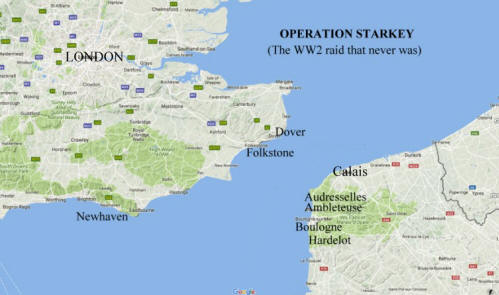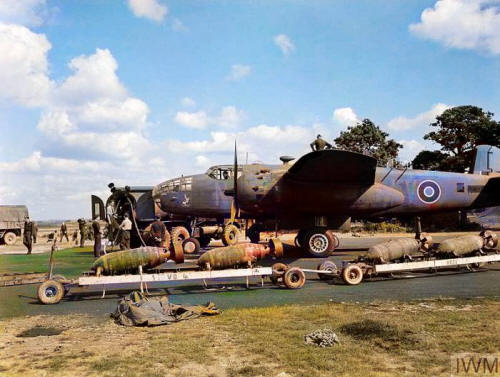|
Operation Starkey - a Deception Raid of 355
Vessels.
The Raid that Never Was
Operation
Starkey was the invasion that never was. The
war years are littered with stories of deception designed to confuse
the enemy or to make them believe something that was no more than a
figment of the planners' imaginations! Systematic bombing of
selected targets, over several weeks in late August and early September
1943 and an invasion armada of empty ships, were the key elements.
An
ever-increasing amount of information is now easily accessible in the public
domain about D Day, the invasion of France on 6 June 1944. However, the same cannot
be said about the events of the previous summer of 1943. The ambitious plan,
code named ' Operation Starkey', was to use British and Canadian troops, the Royal Navy and the Air Forces of Britain and the United States, in preparations described as 'consistent with an assault on Boulogne'.
The insertion of the word 'consistent' introduces the element of deception into
the planning and execution of the operation.
Boulogne
was among the most heavily-defended parts of the Pas de Calais region of
Northern France. The planned operation was primarily a feint but with an eye on
the prospect of it becoming an actuality 'should the circumstances become propitious'.
This might happen, for example, if the enemy's hold over that part of the Continent showed signs of disintegrating.
The opportunity would then exist to turn play-acting into reality.
 It was a momentous concept: British and Canadian troops, in their thousands, to be ready to go into the assembly areas; battleships to turn their massive guns against the German coastal batteries; some 15,000 fighter sorties with 3,000 sorties by medium and heavy bombers in daylight and as many by night. It was a momentous concept: British and Canadian troops, in their thousands, to be ready to go into the assembly areas; battleships to turn their massive guns against the German coastal batteries; some 15,000 fighter sorties with 3,000 sorties by medium and heavy bombers in daylight and as many by night.
[Map courtesy of Google Map Data 2017].
The landing beaches were between Audresselles and
Ambleteuse, six miles north of Boulogne, and those between the River Brone and Hardelot, seven miles south of Boulogne with subsidiary attacks by seaborne
Commandos, Royal Marines and paratroops. A further landing, at the seaside resort of Le Portel,
was planned to thwart any enemy bid to destroy the port of Boulogne, before its seizure by the invading forces.
However, the planned operation was progressively watered down for various
reasons, including a lack of resources and opposition from influential 'top brass'.
One such was 'Bomber' Harris, who described the idea as 'at best a piece of
harmless play-acting'. While the commitment to an actual assault by land forces
was on the wane, efforts to convince the enemy that an invasion was likely
in that area of Northern France, were intensified. Naval and air operations and extensive troop movements in Southern England,
consistent with genuine preparations for such a landing, continued apace. The First Canadian Army moved into deployment areas in the Portsmouth/Southampton sector and the British Second Army into the
Dover / Folkestone / Newhaven sector, as landing craft assembled along the coast from Portsmouth to Dover.
 In the
'Preliminary Phase', from 16 to 24 August, around 680 USAAF and 156 RAF aircraft,
bombed airfields, transportation, industrial and other targets. In the 'Preparatory Phase',
from 25 August to 8 September, the bomber force swelled to 1,754 and 640 respectively, with the weight of the high explosives
used increasing from an overall 1,454 tons to 2,683 tons. Concurrently,
the targets were broadened to include ammunition and fuel dumps concealed among the forests inland from Boulogne. In the
'Preliminary Phase', from 16 to 24 August, around 680 USAAF and 156 RAF aircraft,
bombed airfields, transportation, industrial and other targets. In the 'Preparatory Phase',
from 25 August to 8 September, the bomber force swelled to 1,754 and 640 respectively, with the weight of the high explosives
used increasing from an overall 1,454 tons to 2,683 tons. Concurrently,
the targets were broadened to include ammunition and fuel dumps concealed among the forests inland from Boulogne.
[Colourised Photo;
North American Mitchell Mark II, FV916 'EV-N' of No. 180
Squadron RAF, being refuelled and bombed up at Dunsford, Surrey, between
cross-Channel sorties in support of Operation STARKEY. © IWM (CH 11038)].
In the 'Culminating Phase',
from 8 to 9 September, the USAAF and RAF bombers switched their attention to gun sites,
a well understood prerequisite to any seaborne invasion force. Bombing them would surely heighten the enemy's expectations of an imminent landing in the Pas de Calais,
which was still the primary purpose of Operation Starkey, despite its considerably reduced scale.
Daybreak, on 9 September 1943,
witnessed a level of activity not seen since the Dunkirk evacuation in the
summer of 1940. A 355-strong mini-armada was sailing towards France but
all was not as it seemed. It comprised a motley array of vessels, including self-propelled Thames barges
and cross-Channel pleasure steamers with escorting destroyers, ready to
beat off any enemy attack... but they were all but empty!
The
final act of the 'performance' happened when the entire mile-wide 'assault
force' turned 180 degree, the trigger being a coded signal 'Backchat'
received at 09.00. The synchronised manoeuvre must have been an wondrous sight.
It was the invasion
that never was. It attracted little interest among the enemy but it cost many French lives in the bombing attacks. Le Portel,
which nestled between two key gun
emplacements, suffered grievously with the loss of 500 lives. Without the
precision weapons of modern times, collateral damage was inevitable but no
less regrettable.
Further Reading
There are around 300 books listed on
our 'Combined Operations Books' page. They, or any
other books you know about, can be purchased on-line from the
Advanced Book Exchange (ABE). Their search banner link, on our 'Books' page, checks the shelves of
thousands of book shops world-wide. Just type in, or copy and paste the
title of your choice, or use the 'keyword' box for book suggestions.
There's no obligation to buy, no registration and no passwords.
The Starkey Sacrifice: The Allied Bombing of Le Portel 1943
by Michael Cumming, Sutton Publishing, 1996.
Deception in World War II,
by Charles Cruickshank, OUP, 1981; j

Acknowledgements
Written by
Michael Cumming, Surbiton, England and updated by Geoff Slee in 2017.
with map & photograph.
|



